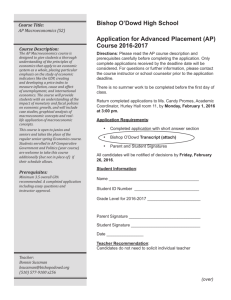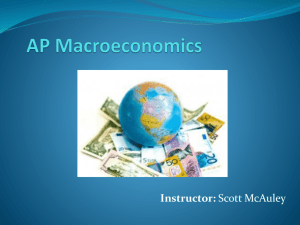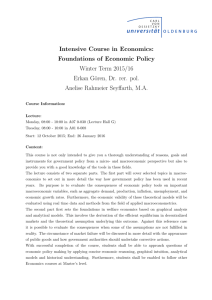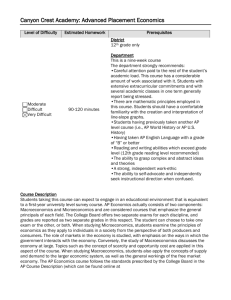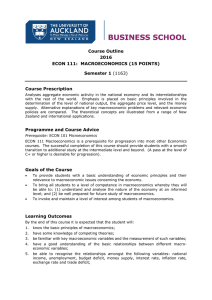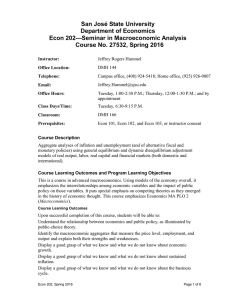Economics 157b Economic History, Policy, and Theory Short
advertisement
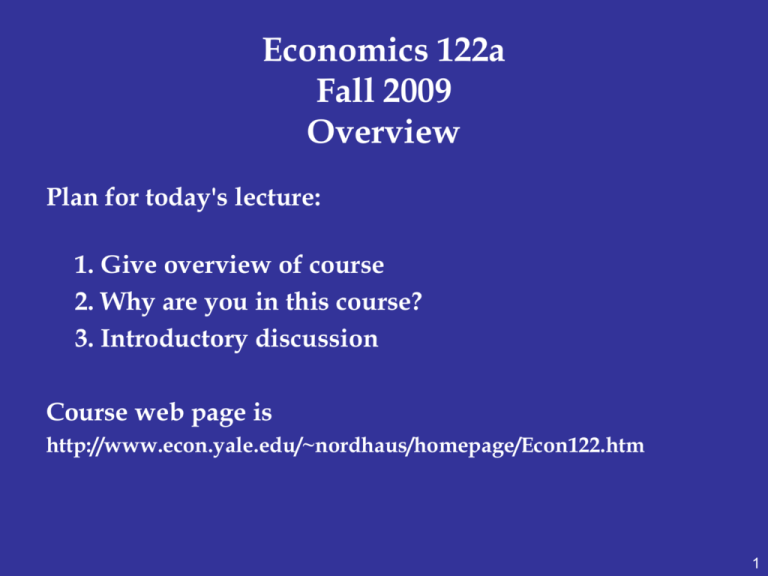
Economics 122a Fall 2009 Overview Plan for today's lecture: 1. Give overview of course 2. Why are you in this course? 3. Introductory discussion Course web page is http://www.econ.yale.edu/~nordhaus/homepage/Econ122.htm 1 Introduction and setup 1. What is this course? 2. Go over course setup 3. Go over readings 4. Lecture and sections 5. Problems and exams 6. Paper Exodus 2 Limited enrollment Limit to 120 students. The following are GUARANTEED enrollment: all those who got bumped last year; all seniors and juniors who are shoppers as of 7 pm Monday; all sophomores who are declared economic majors as of 7 pm Monday. The balance of shoppers will be selected by lottery. My guess is that the odds are about 1 in 3 of selection. Freshmen are not eligible. Special cases will be considered on an individual basis. 3 Course Syllabus DESCRIPTION AND PREREQUISITES • The course covers business cycles, economic growth, major macro topics, and their application to fiscal and monetary policy and history. • Highlights: – the major tools of macroeconomic analysis, particularly understanding business cycles and economic growth and – Some major historical and policy issues. • This course is to be taken after completing both terms of Introductory Economics. Exceptions will be rare. Calculus will be used. 4 Readings The textbook for the course is the following. For textbook options, see web page. N. Gregory Mankiw, Macroeconomics, 7th edition, Worth, 2010. The book is not in yet, but you can download the first chapters from the course web site. Note the options: • Mankiw, 7th edition from Yale bookstore for circa $170 (should be in soon) • Mankiw, 7th edition, in the electronic version, from CourseSmart for $62 for a 180 day subscription. • Mankiw, sixth edition, available various from $10 on up. This is for impecunious risk-lovers. 5 Electronic readings Most of the non-text articles are available in electronic form on the course web site under the heading “Online Readings.” These articles are marked (E) on the reading list and available from the course web site or online. 6 Posting of lecture notes Lectures will be posted after the class. 7 Tests and Grading There will be one mid-term examination, which will take place in class on Wednesday, October 21. The final examination will be three hours and is Dec 17. There will be four graded problem sets, four ungraded but required problem sets, and a short paper on a historical or policy macroeconomic issue due at the end of the semester. The grade is approximately based 45 percent on the final exam, 25 percent on the hour tests, and 30 percent on the problems and paper. Grade distribution. 8 Sections There will be sections led by teaching fellows from Department of Economics. Each student will be assigned to a section. Sections will go over the analytical material from the course, cover questions raised by students, and review problems and exams. Tentative section times are: Wednesday 4:00-4:50 and 5:00-5:50 Thursday 4:00-4:50 and 5:00-5:50 Wednesday 7:00-7:50 and 8:00-8:50 9 How to master macroeconomics Experience and modern neuroscience show that better performance and more persistent understanding comes from keeping up with the reading, consistent attendance in the course and sections, along with careful work on the problem sets. 10 Alternatives Alternative macroeconomics courses: Econ 122 (Bruegemann). Roughly the same with emphasis on labor economics. Econ 126 (Moscarini). Intensive version. More analytical and mathematical. 11 For those who have had enough macroeconomics for today... 12 Why are you here? Before we go on, reflect a moment and then write the answer to the following on a piece of paper: “Why am I here? What do I hope to get out of this course?” 13 What is macroeconomics? • Macroeconomics is the study of the overall behavior of economies (output, inflation, unemployment, trade balance, financial markets, …) • Economies are not just the sum of the parts. The behavior of aggregates is different from the sum of individuals. Non-linear system. – This point is found in many areas. Crowds behave differently from individuals. – riots, traffic jams, panics, sports, … 14 Major themes There are two major recurrent themes running through macro: i) Business cycles ii) Economic growth Virtually every macroeconomic issue revolves around these issues, or a confusion concerning them. 15 Business cycles One major set of issues involves the business cycle. What are business cycles? What are some examples? The housing/subprime recession of 2007-09. – Housing prices peaked in mid 2006 and have fallen about 20 percent. – In August 2007, investors suddenly discovered that subprime mortgages were much riskier than had been supposed. – This led to financial problems, especially for highly leveraged financial intermediaries (banks, hedge funds, etc.), bankruptcies, and other crises – Risk premiums increased, credit was tightened. – The Fed responded forcefully right away on a broad front. – But we seem to be headed for the most severe recession since World War II. 16 Output and employment over the cycle 1.06 Employment/trend Output/potential Deviation from trend 1.04 1.02 1.00 0.98 0.96 0.94 0.92 60 65 70 75 80 85 90 95 00 05 10 17 The central question of macroeconomics “The resources of nature and man’s devices are just as fertile and productive as they were. The rate of our progress towards solving the material problems of life is not less rapid. We are as capable as before of affording for everyone a high standard of life and will soon learn to afford a standard higher still. But today we have involved ourselves in a colossal muddle, having blundered in the control of a delicate machine, the working of which we do not understand.” [J.M. Keynes, The Great Slump of 1930 18 Debt-GDP ratio under two CBO scenarios 19 Economic growth Economic growth concerns the trend in output over the long run. In macroeconomics, we use the neoclassical growth model to understand economic growth. GDP (2007 international prices, billions of $) GDP trends in 3 big regions 10,000 1,000 China US SubSaharanAfrica 100 1960 1970 1980 1990 2000 2007 21 GDP per capita (2007 international US dollars) Per capita growth trends in 3 big regions 20,000 China US SubSaharanAfrica 2,000 200 1980 1985 1990 1995 2000 2007 22 International macro A final slant on these issues that is important is international macroeconomics -- a new and fascinating branch of economics. Role of exchange rates, international trade, currencies. Biggest issues now are the huge current account deficit of the US and the big surplus of China. How will these resolve? In a gradual unwinding? Or in a financial meltdown? 23 U.S. Trade Deficit: Net exports/GDP (%) .02 .01 Net exports/GDP .00 -.01 -.02 -.03 -.04 -What does this mean? That US is consuming more than it is producing. - Major questions: how long can this go on, and how will it end (gradual adjustment or hard crash)? -.05 -.06 -.07 60 65 70 75 80 85 90 95 00 05 10 24


